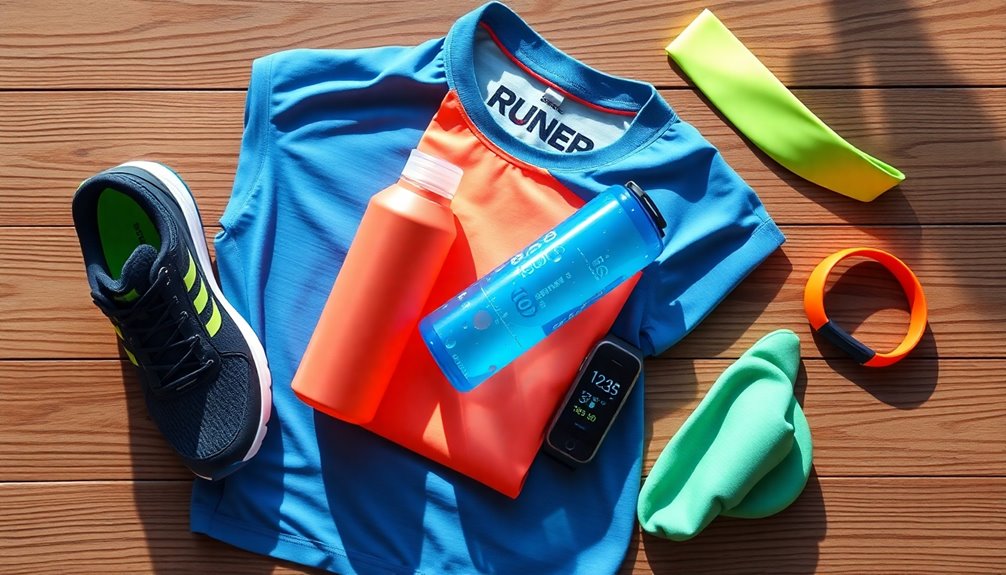Starting a running routine is rewarding and great for your health, no matter your age. Get properly fitted running shoes and moisture-wicking clothes to keep comfortable. Before you begin, check with a doctor, especially if you're inactive or have health concerns. Try the run-walk method to build endurance safely. Stay safe by wearing reflective gear and knowing your surroundings. Consistency is key, so aim to establish a routine that suits your lifestyle. You'll find even more tips for success ahead.
Key Takeaways
- Start with a medical clearance to ensure safety, especially if you're inactive or have health concerns.
- Invest in proper running shoes and moisture-wicking clothing to enhance comfort and reduce injury risk.
- Use the run-walk method to gradually build endurance while minimizing the chance of injury.
- Establish a consistent routine by running 3-4 times a week and tracking your progress for motivation.
- Focus on proper running technique, including posture, breathing, and footstrike, to improve efficiency and reduce injury risk.
Benefits of Starting a Running Routine

Starting a running routine can bring a sense of accomplishment and energy to your life. Not only does running build cardiovascular endurance, but it also greatly boosts your heart health.
You'll find that consistent running can help with weight loss, burning about 100 calories per mile to create a calorie deficit. Plus, it's an excellent way to relieve stress; as you run, your body releases endorphins that enhance your mood and promote mental well-being.
Regardless of your age or fitness level, you can start running, with many people beginning their journeys in their 50s and 60s. Establishing a consistent running habit improves sleep quality, leading to better recovery and overall health benefits that'll keep you feeling great.
Essential Gear for New Runners

Before hitting the pavement, it's vital to equip yourself with the right gear to guarantee a comfortable and safe running experience.
Here are three essentials you'll need:
- Running Shoes That Fit: Invest in a good pair of running shoes, ideally with a professional fitting to determine your foot type and pronation.
- Moisture-Wicking Clothing: Choose clothing that keeps sweat away from your skin, enhancing comfort and reducing chafing on your runs.
- Properly Fitting Sports Bra: For women, a supportive sports bra is necessary to minimize discomfort and enhance performance.
Consider adding accessories like reflective gear for safety during low-light conditions and hydration solutions for longer runs.
As you progress, think about incorporating a fitness tracker to monitor your performance.
Getting Medical Clearance Before You Start

Before you lace up your running shoes, it's crucial to get medical clearance, especially if you haven't been active lately or have any existing health issues.
A quick check-up can help spot potential risks and guarantee you're ready for the challenge ahead.
Your doctor can also recommend a tailored plan to safely ease you into running.
Importance of Medical Clearance
While diving into a new running routine can be exciting, it's important to prioritize your health by consulting a doctor first. Obtaining medical clearance guarantees safety and helps prevent injuries, especially if you've been sedentary or have pre-existing health conditions.
Here's why it's essential:
- Identify Risks: A medical check-up can uncover any underlying health issues, like cardiovascular problems, that may worsen with increased activity.
- Tailored Guidance: Healthcare providers can suggest suitable exercises based on your health status, aligning with recommendations from the American Heart Association.
- Injury Prevention: Listening to your body and heeding medical advice can protect you from serious injuries or complications as you start your exercise routine.
Always take this step before you begin!
Identifying Health Conditions
Getting medical clearance is a vital step in starting your running journey, especially if you have health concerns or haven't exercised in a while.
It's important to consult a healthcare professional for a medical evaluation, particularly if you have pre-existing health conditions like heart disease, diabetes, or joint issues. They can identify potential risks associated with running and help create a safe exercise plan tailored to your needs.
Consider factors such as age, weight, and family medical history, as these can contribute to health complications. Always disclose any medications you're taking, as they can affect your heart rate or performance.
If you experience unusual symptoms like chest pain or dizziness while running, seek immediate medical attention.
The Run-Walk Method Explained

The Run-Walk Method is a fantastic way to ease into running without pushing your limits too hard.
By alternating between running and walking, you can build endurance while reducing the risk of injury.
Let's explore the benefits of this approach and some tips to help you progress effectively.
Benefits of Run-Walk
Starting your running journey can feel overwhelming, but the Run-Walk Method offers a practical solution. This approach combines running and walking to help you ease into the sport while building endurance.
Here are three key benefits:
- Reduce the Risk of Injury: By incorporating run-walk intervals, you allow your muscles to recover during walking periods, minimizing strain.
- Confidence in Running: New runners can start with shorter running intervals, gradually increasing them as fitness improves, fostering a sense of achievement.
- Sustainable Running Routine: This method encourages you to progressively increase your running time, making it easier to stick with your routine long-term. Additionally, incorporating low-impact exercises can complement your running efforts and reduce the risk of injury.
Progression Tips and Techniques
Building on the benefits of the Run-Walk Method, understanding how to progress effectively is key to your success as a new runner.
Start with consistent walking sessions of 10-30 minutes to guarantee you're comfortable before adding running intervals. As you feel ready, gradually increase your running time while decreasing walking breaks, always following the 10% rule—never increase your total running time by more than 10% each week to prevent injury.
Keep track of your intervals, adjusting as needed to maintain motivation. Focus on building your running endurance slowly, and don't rush the process.
Setting Realistic Goals for Your Running Journey

Setting realistic goals is essential for ensuring a successful running journey, especially when you’re just starting out. Here are a few tips to help you stay on track: It’s important to focus on gradual improvements rather than expecting immediate results. Start with a manageable distance or time, and increase it incrementally to avoid injury and build your endurance. For those looking for more guidance, there are numerous resources available that offer helpful tips for beginner runners to enhance their overall experience and maintain motivation throughout their training.
- Set achievable short-term goals: Aim to run for 10-20 minutes three times a week to build confidence.
- Gradually increase your running duration: Add about 10% more each week to safely enhance endurance.
- Incorporate a mix of running and walking intervals: Start with 1-minute runs followed by 2-minute walks to ease into it.
As you establish your new running routine, make sure to track your progress in a running log.
Define your long-term goals, like completing a 5K, to stay motivated while running for longer periods.
Celebrate your milestones along the way!
Practicing Proper Running Technique

To run effectively, you need to focus on your posture, footstrike, and breathing techniques.
Keeping your body upright and landing on your midfoot can greatly improve your efficiency and reduce injury risks.
Maintaining Good Posture
Maintaining good posture while running is essential for beginners, as it not only enhances your performance but also reduces the risk of injury. Here are some key points to remember:
- Upright Posture: Keep your head high, eyes looking forward, and spine aligned to reduce strain on your neck and shoulders.
- Relax Your Shoulders: Let your shoulders drop away from your ears, allowing your arms to swing naturally and freely.
- Engage Your Core Muscles: Stabilize your torso to maintain balance and improve running efficiency.
Additionally, focus on landing softly on your midfoot to promote a smoother running motion while ensuring your arms swing at a 90-degree angle to aid in your proper running form and maintain your running gait.
Breathing Techniques
While you're focusing on your running technique, mastering proper breathing techniques is essential for maximizing your performance and endurance.
Start by practicing diaphragmatic breathing; inhale deeply through your nose to expand your abdomen, increasing your oxygen intake. Aim for a rhythmic breathing pattern, like the 2:2 method, inhaling for two steps and exhaling for two steps to maintain a consistent breathing rhythm.
Make sure to focus on a full exhale to efficiently expel carbon dioxide, which can enhance your stamina. During easy runs, experiment with nasal breathing for better oxygen utilization and relaxation.
Finally, remember that maintaining good posture while running allows for better lung expansion and overall breathing efficiency, further supporting your endurance goals.
Footstrike and Cadence
Mastering your footstrike and cadence is essential for developing a strong running technique. Focus on these key aspects to improve your running form:
- Footstrike Type: Aim for a midfoot strike to reduce injury risk and promote a natural gait. Avoid overstriding and excessive heel striking.
- Running Cadence: Aim for a higher running cadence, ideally between 170-180 steps per minute, to enhance efficiency and minimize joint impact.
- Running Drills: Incorporate drills like high knees, butt kicks, and strides to refine your footstrike technique and monitoring cadence.
Nutrition and Hydration Tips for Runners

To run your best, staying properly nourished and hydrated is essential. Aim to drink 16-20 ounces of water 1-2 hours before your run, plus an additional 8 ounces just before you start.
For runs longer than 45 minutes, consider sports drinks or gels that provide carbohydrates and electrolytes to maintain your energy levels.
A balanced diet is key; aim for 55-65% of your calories from carbohydrates, 15-20% from protein, and 20-30% from healthy fats.
Don't forget post-run recovery; consume a meal or snack with carbs and protein within 30 minutes—think a banana with peanut butter or a protein smoothie.
Incorporate antioxidant-rich foods like berries and leafy greens to help reduce inflammation and support overall recovery.
Staying Safe While Running

Staying safe while running is essential, especially when you're out on your own. To guarantee your running safety, follow these tips:
- Wear reflective clothing: Choose visible gear during early morning or evening runs to enhance visibility.
- Stay aware of your surroundings: Avoid headphones or keep the volume low to hear potential hazards.
- Run in well-lit areas: Opt for populated spots, particularly when training alone, to deter threats and increase safety.
Additionally, always carry identification and a mobile phone. Let someone know your running route and estimated return time.
These precautions can help you enjoy your runs while minimizing risks. Remember, being prepared is key to a safe running experience!
Building a Consistent Running Habit

Building a consistent running habit can feel intimidating, but with a structured approach, it becomes much more manageable.
Start by establishing a routine; running at the same time each day helps reinforce your habit. Aim for three to four days a week, focusing on easy runs that gradually increase to about 30 minutes.
Remember, consistency is key—aim for 50-150 minutes of running activity per week to build endurance without overwhelming yourself.
On non-running days, incorporate cross-training activities like swimming or cycling to maintain fitness and reduce injury risk.
Keep track of your runs in a journal or app to monitor progress, set goals, and stay motivated.
This way, you'll cultivate a sustainable running habit over time.
Cross-Training and Strengthening for Runners

While running is a fantastic way to improve your fitness, adding cross-training and strength exercises can greatly enhance your performance and help prevent injuries.
Here are three key areas to focus on:
- Cross-Training Activities: Engage in swimming or biking to work different muscle groups, maintain aerobic workouts, and reduce injury risk.
- Strength Training: Incorporate exercises like squats, lunges, and planks at least twice a week to build core stability and muscular strength, essential for good running form.
- Flexibility Exercises: Regularly practice yoga or dynamic stretching to improve range of motion, recovery, and running efficiency.
Frequently Asked Questions
How Should a Beginner Start Running?
To start running, you should begin with brisk walking for 30 minutes, three to five times a week.
Once you feel comfortable, try the run/walk method—jog for a minute, then walk for a minute.
Gradually increase your running intervals and aim for 20-30 minutes continuously.
Stick to a consistent schedule and invest in a good pair of running shoes.
This'll help you build a solid foundation while minimizing injury risks.
What Is the 80% Rule in Running?
Think of your running routine like a well-balanced meal.
The 80% rule in running means you should spend about 80% of your weekly mileage at an easy, conversational pace. This helps you build endurance and recover properly while keeping injuries at bay.
The remaining 20% can focus on high-intensity workouts like tempo runs. By following this approach, you'll create a sustainable training plan that promotes long-term progress and overall fitness.
What Is the Best Running Plan for a Beginner?
The best running plan for you as a beginner is to start with the walk/run method.
Begin by walking for about 10 minutes, then alternate between 1-minute jogging and 1-minute walking for a total of 10 minutes.
Gradually increase your running intervals each week.
Aim to run consistently three to four times a week, allowing for rest days to help your body recover and prevent injuries as you build your endurance.
What Is the 30/30 Method of Running?
The 30/30 method of running is like discovering a secret passageway to fitness!
You alternate between 30 seconds of running at a moderate pace and 30 seconds of walking or slow jogging. This approach helps you build endurance while keeping the experience manageable and fun.
It minimizes injury risk and can be easily adjusted as you progress. Over time, you'll find yourself ready to tackle longer runs with confidence!
Conclusion
Starting a running routine can transform your life, and you're not alone in this journey—over 50% of people who begin running stick with it for at least six months! By following the tips in this guide, you'll not only enjoy the physical benefits but also boost your mental well-being. Remember, every step counts, so lace up those shoes and hit the pavement. You've got this, and the finish line is just the beginning of your adventure!









